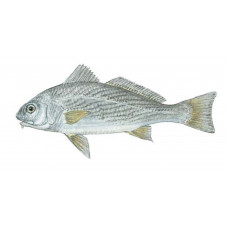Latin name
Umbrina roncador
Other names
Atalina croaker, yellowtailed croaker, golden croaker, yellowfin drum.
Identification
The body of the yellowfin croaker is elliptically elongated, the back somewhat arched, and the head blunt. The coloration is iridescent, from blue to gray, with brassy reflections on the back dissipating to silvery white below. Dark wavy lines run along the sides. The fins are yellowish except for the dark dorsal fins. There is a small barb on the tip of the chin and two strong anal spines; the barb and strong anal spines distinguish the yellowfin from other California croakers.
Distribution
The yellowfin croaker is found from the Gulf of California, Mexico, to Point Conception, California.
Habitat
These fish inhabit shallow parts of bays, channels, harbors, and other nearshore waters over sandy bottoms.
Size
The average weight of a yellowfin croaker is less than 1 pound. The record is 2 pounds 11 ounces.
Life history and Behavior
The yellowfin croaker reaches sexual maturity at 9 inches in length. The spawning period is in the summer, when this species concentrates along sandy beaches. In winter, they move to deeper waters, moving in schools or in small groups.
Food and feeding habits
The yellowfin croaker mainly consumes small fish and fish fry, also feeds on small crustaceans, worms, mollusks.
Reproduction
Yellowfin croaker become sexually mature at about 2 years of age and 9 inches long. Spawning takes place from May to August.
| Classification | |
| Phylum | Chordata |
| Class | Actinopterygii |
| Squad | Acanthuriformes |
| Family | Sciaenidae |
| Genus | Umbrina |
| Species | U.roncador |
| Features | |
| Conservation status | No information |
| Habitat | bottom |
| Life span, years | No information |
| Maximum body weight, kg | 2.04 |
| Maximum length, cm | 51.13 |
| Sailing speed, m/s | No information |
| Threat to people | Edible |
| Way of eating | Bentophage |


